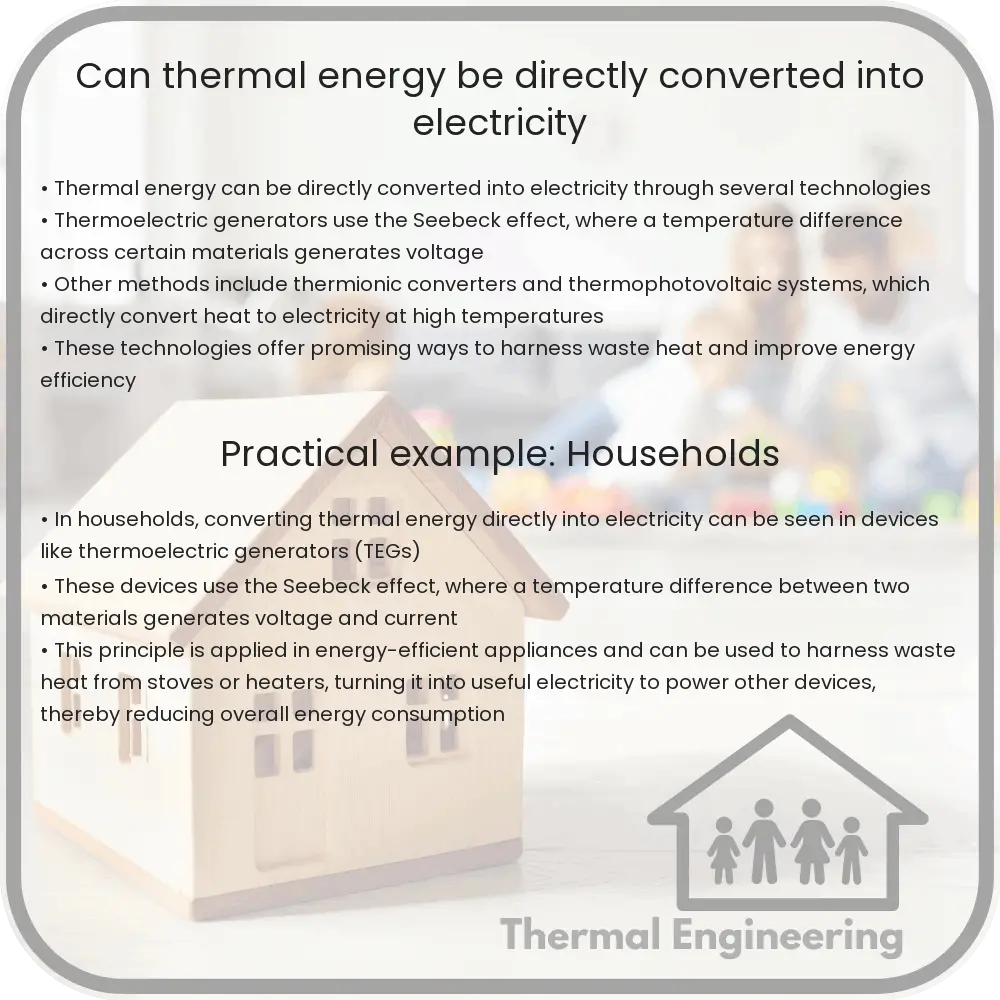Learn how thermal energy can be directly converted into electricity through technologies like thermoelectric generators, thermionic converters, and thermophotovoltaic systems.

Converting Thermal Energy Directly into Electricity
One of the intriguing aspects of engineering is the quest to efficiently convert one form of energy into another. A common question that arises in this field is whether thermal energy can be directly converted into electricity. The answer is yes, and this is primarily achieved through processes such as thermoelectric generation, thermionic conversion, and thermophotovoltaic conversion. Each of these processes harnesses heat differently to produce electrical energy.
Thermoelectric Generators (TEGs)
Thermoelectric generators convert temperature differences directly into electrical voltage through a phenomenon known as the Seebeck effect. When there is a temperature difference between two different types of materials, an electric voltage is generated at the junctions of the materials. Here is a simplistic explanation of the process:
- Seebeck Effect: This effect occurs when two dissimilar conductors or semiconductors are exposed to different temperatures, creating a voltage difference. A thermoelectric device exploits this by connecting multiple pairs of these materials in series, forming a thermoelectric module.
- Material Science: The efficiency of TEGs heavily depends on the materials used. Recent advancements include the use of bismuth telluride (Bi2Te3) and skutterudites, which have shown superior thermoelectric properties at room and higher temperatures, respectively.
Though practical and relatively simple, the efficiency of thermoelectric generators is generally low, ranging between 5-8%. Engineers continue to explore new materials and configurations to improve this efficiency.
Thermionic Converters
Thermionic energy conversion is another direct method where thermal energy is converted to electrical energy through the emission of electrons from a hot material. Here’s how it functions:
- Electron Emission: When a material is heated to a high temperature, it can emit electrons, a principle that is similar to how old vacuum tubes worked. These free electrons can be captured as an electric current.
- Cathode and Anode: A typical thermionic converter has a hot cathode and a cooler anode. Electrons evaporate from the cathode and are collected at the anode, thus creating a flow of electricity.
Thermionic converters can potentially achieve higher efficiencies, especially when operated at very high temperatures. However, challenges such as material degradation and the need for a vacuum or special environment have limited their utility.
Thermophotovoltaic (TPV) Systems
Thermophotovoltaic systems convert thermal energy into electrical energy using photovoltaic cells. Instead of capturing sunlight, TPV systems capture photons emitted by a hot emitter:
- Photonic Emission: A thermally excited material radiates photons, which are then absorbed by photovoltaic cells customarily designed to maximize energy capture from this specific spectrum of radiation.
- Material Choices: Considerations for materials in TPV systems include the emitter material and the photovoltaic cell composition, which must be matched effectively to the radiation spectrum for increased efficiency.
TPV systems can be useful in scenarios where waste heat is available, such as industrial processes or power plants. They offer a compelling way to reclaim energy that would otherwise be lost to the environment.
Conclusion
The direct conversion of thermal energy to electricity is not only possible but is implemented in various technologies each with its own set of challenges and benefits. As material science progresses and new technologies emerge, the efficiency and applications of these conversions will likely improve, leading to broader adoption and new applications in both energy recovery and direct heat-to-power applications.
Understanding these technologies and their potential helps to appreciate the innovative solutions engineering provides in the challenge of efficient energy conversion, highlighting the importance of continued research and development in this crucial area.